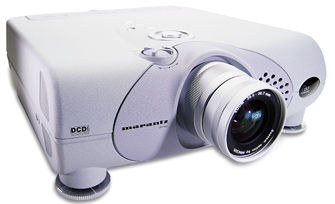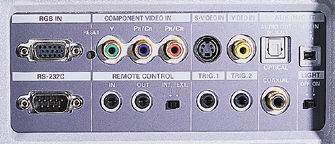Marantz VP-12S1 DLP Projector

Aesthetically, the VP-12S1 has a handsome industrial design. My review sample had a light-gray metallic finish. It's fairly compact in size, measuring just 15.94 inches wide by 18.56 deep by 6.125 high. Weighing in at a hefty 26.1 pounds, this projector has the best build quality of any of the new 1,280-by-720 one-chip DLP projectors I've tested to date. The remote leaves a lot to be desired, though. It's very small, and all of the buttons are the same size. This, combined with its lack of backlighting, makes it awkward in any environment and impossible to use in the dark.
The VP-12S1's connectivity options include one 15-pin VGA-style RGB input, one broadband component video input, one S-video input, one composite video input, one RS-232 control port for use with a Crestron or AMX touchpanel control system, a coaxial and optical digital audio output, one IEEE 1394 input that's adapted for digital video camera playback, two 12-volt trigger outputs for electric drop and electric masking screens, and a remote input and output. I set up the projector using the RGB input for my Dish Network HD source and the component video in for my DVD player.

Useful features include three color-temperature settings (low, middle, and high), a choice of a 0- or 7.5-IRE black-level setting, nine picture memories that let you store different picture settings for different sources, and four aspect-ratio settings (normal for 4:3, full for anamorphic, zoom for letterbox, and through, which bypasses the internal scaler and uses only the Faroudja processing at 720 by 480 pixels). If the image placement isn't correct, a lens-shift feature lets you center the picture vertically on your screen. Horizontal and vertical keystone adjustments also add to the projector's versatility.
The VP-12S1 offers some excellent performance-enhancing features, as well. The 3:2-pulldown detection and superb Faroudja DCDi deinterlacing chip combine to provide state-of-the-art video processing for NTSC sources like DVD and DBS. Custom all-glass optics by Minolta undoubtedly help the projector deliver extremely sharp, highly detailed images. Thanks to the double-sealed cabinet structure, there's virtually no light leakage. A noise-canceling duct system helps minimize fan noise: In fact, the VP-12S1 is so quiet that—even if you were to position it on the ceiling directly above your seating position—you'd be hard-pressed to hear it except during a film's quietest passages.
Unfortunately, the VP-12S1 doesn't have gain or bias controls, which makes it impossible to adjust the gray scale. The good news is that the VP-12S1's gray-scale calibration from the factory is quite good (see the measurements box).
I used the VP-12S1 in two different setups. First, I did a straight-throw rear configuration onto a 10-foot-wide 16:9 Stewart Aeroview screen with 0 gain, driven by a Panasonic DVD-RP91 DVD player. Considering the VP-12S1's relatively small 150-watt super high pressure (SHP) short-arc metal halide lamp, I was pleasantly surprised by its ability to easily drive a screen this size with ample light output. I had to set the contrast to 92; however, when I checked the stepped gray pattern from the Video Essentials disc, I was able to take the contrast all the way up to 100 without causing any visible clipping or crushing of whites. I was also pleasantly surprised to see only a very slight gray-scale shift, which means that the projector's gamma is excellent. Most DLP projectors (and other fixed-pixel displays) have significant gray-scale shifts at different contrast settings. White-field uniformity (the evenness of white across the screen on a white field) was also exceptional, as you'd expect from a DLP projector. Chapter 4 of Hollow Man (when they make the ape visible again) was breathtaking. Detail and color fidelity were both superb. Chapters 4 and 5 of Jurassic Park III were equally impressive, with outstandingly natural skintone rendition.
- Log in or register to post comments


























































